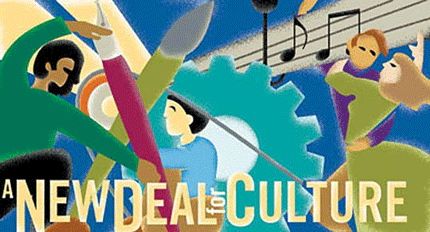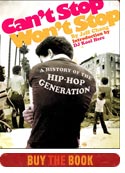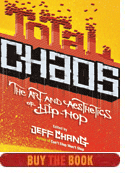The Nation
May 4, 2009

Image by Ennis Carter, Design For Social Impact
This piece began as a brief acceptance speech for my 2008 North Star News Prize Award. I was trying to spell out the key roles that journalists, artists, and organizers played in bringing about Obama’s victory, all jobs that were looked down upon and that I–of course–had held during the 20+ years of my so-called career. Katrina vanden Heuvel of The Nation liked it and commissioned it for the magazine.
Over the next three months, I found myself thinking about creativity’s role in social change around the world, from the Great Depression through now. I soaked up game from people like Roberta Uno, Caron Atlas, Greg Morozumi, Jenny Toomey, and former NEA chief Bill Ivey. I slogged through quite a few wack drafts with a patient editor, Richard Kim, when the piece suddenly cohered into a commentary on the horrible state of arts and cultural policy in the U.S.
The original went live online here on April 15. 2009. Below is my version…I’ve restored a few words that were cut for space. Extensive links to come soon…
On Inauguration Day, Tom Brokaw was moved to compare Barack Obama’s election to Czechoslovakia’s 1989 Velvet Revolution. At the eye of both storms, of course, was an icon who merged the political and aesthetic—Vaclav Havel, the rock-star poet and prophet, and Barack Obama, the post-soul master of his own story. Both struck down eras of monocultural repression with their pens.
Artists played a largely unheralded role in Obama’s victory. But they had been tugging the national unconscious forward for decades, from the multiculturalist avant-gardes of the ‘70s and ‘80s to the hip-hop rebels of the ‘90s and ‘00s, plying a fearless, sometimes even unruly kind of polyculturalism. By the final months of the election season, they had secured Obama as the waking image of change.
Every moment of major social change requires a collective leap of imagination. Political transformation must be accompanied not just by spontaneous and organized expressions of unrest and risk, but by an explosion of mass creativity. Little wonder that two of the most maligned jobs during the 40 years after Richard Nixon’s 1968 election sealed the “Silent Majority” backlash were community organizer and artist.
Obama was both. So why haven’t community organizers and artists been offered a greater role in the national recovery?
During the transition, arts advocates surfaced some big ideas—including the creation of an Arts Corps to bring young artists into underfunded schools, the expansion of unemployment support and job retraining to those working in creative industries and the appointment of a senior-level “Arts Czar” in the administration. But in practice, they faced dealing with the wreckage left by a nearly three-decade long culture war.
In January, they lobbied for a $50 million request for the NEA in the stimulus package and prevailed over Republican opposition. The one-time allocation will preserve over 14,000 jobs, allow for new stimulus grants and leverage hundreds of millions more in private support for the arts. Two million Americans list “artist” as their primary occupation. Nearly six million US workers are employed in the nonprofit arts-and culture complex alone. In the words of the NEA’s Patrice Walker Powell, the stimulus vote finally “dignified (them) as part of the American work force.”
The victory reflected how notions of the value of creativity have changed. During the last decade, discussions advanced beyond the dead-end debates about the limits of government-funded free expression. Boom-era theorists like Richard Florida and Elizabeth Currid, not to mention Hollywood bulls like Darren Star (“Sex And The City”) or Doug Ellin (“Entourage”), helped make creatives sexy again. Groups like the US Conference of Mayors dreamed not just of expanding cultural tourism or fostering post-industrial innovation, but of attracting new chai latte-sipping bourgeoisies into decaying parts of town. The economic value of creativity was so firmly established by the mid-90s that it helped drive the ravenous appetite for global corporate consolidation once the Clinton administration began sweeping aside ownership caps and deregulating markets.
For decades, the de facto policy has been to confuse the culture industry with the source of creativity, and to largely abandon the production, promotion, distribution and enjoyment of arts and culture to the dictates of the boom-bust marketplace. The result has been the spread of “lifestyle economies” that are merely new forms of monoculturalism and the rise of an environment increasingly antithetical to creativity. A wave of deregulation in the culture industry has consolidated distribution channels and destroyed local scenes, locked away sources of inspiration behind fences of “rights management” and copyright and favored a “blockbuster or die” approach that raises barriers to entry and creates diseconomies of scale. Call it the privatization of the imagination.
So it is important to restate the case for public funding of culture. President Obama recently signed into law a $155 million budget for the NEA. He has also created a White House position on culture and the arts and is expected to appoint Kareem Dale, a Chicago lawyer who worked on the Obama campaign Some advocates believe this may signal an executive shift away from a position of culture-war footing to a higher level of presidential engagement in creativity policy.
Still, Dale will be no ‘Arts Czar’. Instead he will likely be juggling his duties with previously assigned responsibilities for the President around disability policy. And, Flight of the Conchords fans take note,the NEA funding is still less than New Zealand’s annual cultural budget. Even adding in an additional $155 million allocation to the NEH, we still have nothing closely resembling a national commitment to creativity.
What we might call “the creativity stimulus” goes far beyond job creation and even economic development. Culture is not just something that conservatives wage war on. The arts are not just something that liberals dress up for on weekends. Creativity can be a powerful form of organizing communities from the bottom up. The economic crisis gives us a chance to rethink the role of creativity in making a vibrant economy and civil society. Both artists and community organizers cultivate new forms of knowledge and consciousness. One of the unsung stories of the past 25 years is how both have used creativity to inspire community development and renewal. Creativity has become the very glue of social cohesion in times of turmoil.
In Detroit, the James and Grace Lee Boggs Center to Nurture Community Leadership, built around the inimitable 93 year-old woman who gives the center its name, has served as a home for some of the city’s sharpest young organizers and artists in its Detroit Summer program. One of them, the acclaimed rapper Invincible, has produced an 11-minute video for her song “Locusts” that serves not just as a fine documentary of the Center’s work against gentrification and displacement or a profound meditation on the Motortown’s past, but also as a defiant middle-finger in the face of pessimists like Richard Florida, who all but wrote off Detroit in a recent Atlantic Monthly cover story.
Obama’s green jobs for youth proposal emerged first from Oakland’s Ella Baker Center for Human Rights, where staffers tried to figure out how to make the environmental movement pay attention to the hip-hop youths coming in to the center. On the other side of town, the Eastside Arts Alliance helped revitalize the troubled city’s International District by serving as a haven for socially conscious artists, organizers and intellectuals, bringing together leaders of the Black Arts Movement with those of the hip-hop movement.
Deeply rooted in the communities that made Obama’s victory possible, these centers understand their work as transformational. Their communities are the most vulnerable to assaults on creativity, but they are also incubators of the most innovative ideas and movements of our time. This “creative communities” approach has created a rigorous and vital alternative to both neoliberal and neoconservative versions of change.
Cross-generational dialogues have begun between older activists inspired by the examples of 1930s Works Progress Administration (WPA) arts projects and 1970s Comprehensive Employment and Training Act (CETA) cultural development programs, and the post-NEA-meltdown do-it-yourselfers raised on the independent ethics and aesthetics of hip-hop and punk. Such discussions could help shape a framework for a new cultural policy that focuses on the demonopolization and re-regulation of the culture industry, preserves national arts legacies, restores and upholds localism, aligns corporate interests with individual expression, promotes a radical spirit of diversity and unshackles creativity to rebuild communities and the national economy.
A creativity stimulus policy might follow the example of the distinguished tenure of Brazil’s former cultural minister, Gilberto Gil. The famed musician’s own art collided with the aims of the repressive dictatorship and resulted in his temporary exile at the end of the 1960s. More recently, his desire to re-release three of his most famous songs under a Creative Commons license—songs that he said celebrated “the idea of the permanent transformation of everything that exists, of the uninterrupted re-making that produces culture, life, and the world”—was thwarted by the publisher and owner of his songs, Warner-Chappell Music.
Back in 2003, in his first speech as minister of culture, Gil stated that his aims were to forge “the opening of territory for creativity and new popular languages”, ensure “the availability of space for adventure and daring” and secure “the space of memory and invention.” Our urgent task now is not just to repair the present, but to recover the past and sow the future. When we commit to advancing creativity, we will free these trailblazers to write the new narratives of America.
Interested in more? Check out this interview with Jeff at The Arts Politic.
Can't Stop Won't Stop Extras
- A Can’t Stop Won’t Stop Q+A By Oliver Wang
An exclusive interview about the book from 2004 - A Tribute To Richie Perez
The story of one of the Bronx greats–a Young Lord and a mentor to many. - Interviews With The Author
Four years of print, radio, and video interviews with Jeff Chang. You’ll laugh, you’ll cry, you’ll order Chinese. - Making A Name :: Book Excerpt
It has become myth, a creation myth, this West Bronx party at the end of the summer in 1973… - Writing The Book, Part 1
From 2003, the first blog post on writing “Can’t Stop Won’t Stop”. Can it be that it was all so simple then? - Writing The Book, Part 3 or 2.5
Another blog post on writing “Can’t Stop Won’t Stop” from the eve of release. Bonus angst: that vexing “Asian American question”.
The Reader Archive
- Welcome To The Reader
We’re working out the kinks in this as we both add more content and tweak the landing page. Please stay tuned.
Most Popular Topics
- 2008 Elections
Links to Jeff’s coverage of the 2008 elections for Vibe - Hip-Hop Activism
Links to some of Jeff’s articles on hip-hop activism - Music Writing
Links to some of Jeff’s stuff on music writing. Note: We’re currently trying to properly organize this section and upload lots more.



We work with the Creative Commons license and exercise a "Some Rights Reserved" policy. Feel free to link, distribute, and share written material from cantstopwontstop.com for non-commercial uses only.
Requests for commercial uses of any content here are welcome.

